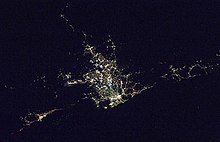Conurbation
He drew attention to the ability of the new technology at the time of electric power and motorised transport to allow cities to spread and agglomerate together, and gave as examples "Midlandton" in England, the Ruhr in Germany, Randstad in the Netherlands, and the Northeastern Seaboard in the United States.
Also various suburban communities such as Agege, Alimosho, Ifako-Ijaiye, Kosofe, Mushin, Oshodi, and Shomolu are included in the area.
The satellite cities of the conurbation include Narayanganj, Gazipur, Tongi, Fatullah, Keraniganj, Tarabo, and Kaliganj.
[6] (Shenyang + Fushun) (Jinzhou + Linghai) (Anshan + Liaoyang) + Zhangjiagang + Jiangyin + Jingjiang + Changzhou + Wuxi) (Hangzhou + Shaoxing + Cixi + Yuyao + Ningbo) (Wenzhou + Longgang + Ruian + Yueqing) (Xiamen + Zhangzhou) (Shantou + Chaozhou + Jieyang) (Hong Kong + Shenzhen + Dongguan + Huizhou + Guangzhou + Foshan + Jiangmen + Zhongshan + Zhuhai + Macau) Data are referred to pre-1974 Turkish Army occupation boundaries.
The area is officially known as the Central National Capital Region (CNCR), a small part of overall NCR.
The Amaravati Metropolitan Region (AMR) of Andhra Pradesh is a conurbation of three cities, namely Vijayawada, Eluru and Guntur and 11 other towns which include Mangalagiri, Tadepalle, Tenali, Ponnuru, Chilakaluripeta, Narasaraopeta, Sattenapally, Nandigama, Jaggayyapeta, Nuzividu, Gudivada and Vuyyuru.
[6] Urban population rate: 17% (2015)[5] Boundaries are referred to the territories administrated by the Republic of China, after Cross-Strait Act (1992).
The list below shows the most populous urban areas in the UK as defined by the Office for National Statistics (ONS).
The largest cities in the region are Toronto, Mississauga, Brampton, Hamilton, Oakville, Burlington, St. Catharines, and Niagara Falls.
The Greater Golden Horseshoe is also part of the Windsor-Quebec Corridor and its southeastern boundary is across the Niagara River from the Buffalo–Niagara Falls metropolitan area in the United States.
Slightly smaller, there are 82 municipalities grouped under the Montreal Metropolitan Community to coordinate issues such as land planning, transportation, and economic development.
The Lower Mainland population is around 2.5 million (as of 2011) and the area has one of the highest growth rates on the continent of up to 9.2 percent from the 2006 census.
The National Capital Region consists of an area of 5,319 square kilometres that straddles the boundary between the provinces of Ontario and Quebec.
As of 2019 an estimated 27,782,000 people lived in Greater Mexico City, making it the largest metropolitan area in North America.
It is surrounded by thin strips of highlands which separate it from other adjacent metropolitan areas, of which the biggest are Puebla, Toluca, and Cuernavaca-Cuautla.
Officially two other cities (Juanacatlán and Ixtlahuacán de los Membrillos) are also considered part of the Metropolitan Area, although they are not contiguous with the other seven.
Most importantly, the cities that compose the Greater Boston CSA are interlinked by heavy public transportation infrastructure, maintain continuously urban interstices, and hold mutual commuting patterns.
The area is also often referred to simply as southern California or colloquially as SoCal (a larger region which includes San Diego).
In 2016, Southern California had a population of 23,800,500, making it slightly larger than the New York Tri-State Area, and is projected to remain so due to a faster growth rate.
Although this is generally all referred to as a single metropolitan area, not a conurbation, it is sometimes broken up into the Miami, Fort Lauderdale, and West Palm Beach metros.
It is the center of The Valley of the Sun which is recognized by the United States Census Bureau as Chandler, Mesa, and Phoenix in the MSA.
This conurbation encompasses 18 counties in Colorado and Wyoming and had an estimated population of 4,976,781 in 2018, an increase of 14.84% since the 2010 United States Census.
In the early 1970s Albury-Wodonga was selected as the primary focus of the Whitlam government's scheme to arrest the uncontrolled growth of Australia's large metropolitan areas (in particular Sydney and Melbourne) by encouraging decentralisation.
[49] This conurbation in New South Wales extends from Newcastle and surrounding satellite towns of the Hunter Valley through the Central Coast.
A built-up area 200 kilometres long[53] which is centred on Brisbane, includes the local government areas (LGAs) of Gold Coast, Ipswich, Logan City, Moreton Bay, Redland City, Sunshine Coast, Noosa Shire, and Tweed Heads, New South Wales.
Broader definitions of South East Queensland are also used, including the separate built-up area of Toowoomba (140 kilometres; 87 miles west of Brisbane), which is not part of the Translink network.
Expansive definitions of South East Queensland give it a population of more than 3.4 million people (2014),[54] covers 22,420 square kilometres (8,660 sq mi), incorporates ten LGAs, and extends 240 kilometres (150 mi) from Noosa in the north to the Gold Coast (some sources include Tweed Heads).
The entire urban area rather than the constituent administrative city was often referred to as "Auckland" by New Zealanders long before formal recognition.
[55] The entire Rio–São Paulo area is also sometimes considered a conurbation, and plans are in the works to connect the cities with a high-speed rail.
However the government of Brazil does not consider this area a single unit for statistical purposes, and population data may not be reliable.





